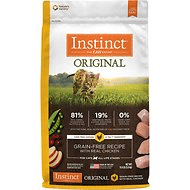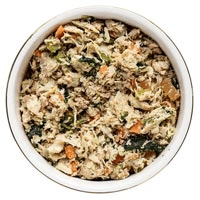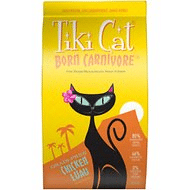Best Dye Free Cat Food: Top Options with No Red Dye
Quick Guide
As a pet owner, we are always making sure that we are feeding our pets the healthiest foods and ensuring them a long, happy life. You might have heard about dyes causing problems in human foods, and you’re wondering if the same can be said for your pet’s food!
If you’ve made it here, you probably have a problem with your cat ingesting dye, but why? What’s so wrong with including food dyes in your cat’s food? Read on to find out why it might be beneficial to avoid dyes in your cat food and which foods are the best.
In this article, you’ll find the top six best cat foods made without dyes, including red dye, caramel color, and other potentially harmful artificial colors.
What is the Best Dye Free Cat Food?
Why avoid food dye in cat food?
A Nielsen Global Survey in 2016 found that artificial colors were one of the top three ingredients consumers avoid, second to artificial flavors and preservatives. Dyes were ranked as more offensive than GMOs, antibiotics or hormones, and gluten.
Some artificial colors are linked to cancer.
Some artificial colors, including Red 40, Yellow 5, Yellow 6, Blue 2, and caramel color are contaminated with known carcinogens and are linked to abnormal cell development.
They might cause behavioral problems in kids.
Studies have found a correlation between hyperactivity and the consumption of artificially-colored foods.
Some cats have red dye intolerances.
Though sometimes referred to as a dye allergy, this isn’t a true allergy in the sense that it doesn’t trigger a histamine response. Proteins typically cause allergies, and food colorants aren’t proteins.
Because they can’t properly process the dye, some cats experience symptoms similar to an allergic reaction. The most common symptoms of a red dye allergy are skin irritation, including redness, itchiness, hives, and rashes. Some intolerant cats experience diarrhea, flatulence, itching, loss of balance, swelling, and vomiting.
But aren’t these dyes approved by the FDA?
While the previously-mentioned research suggests that food dyes may cause cancer and other health problems, the FDA maintains that if used in normal amounts, these dyes will have no harmful effects.
Quick Look : Top 5 Best Dye-Free Cat Foods
Dyes to Watch Out For
Here’s a quick primer on the artificial colors that might appear in your cat’s food.
Red 40 or Allura Red
This is the dye you’ve probably heard the most about. It’s common in cat food, perhaps because it gives brown kibble a red color evocative of fresh raw meat. It may be contaminated with carcinogenic chemicals, may promote tumor development in mice, and has been linked to hyperactivity problems in children.
Yellow 5 or Tartrazine
Like Red 40, Yellow 5 may cause behavioral problems in children, including hyperactivity, aggression, and insomnia. In Europe, manufacturers are required to use a label warning consumers that this dye is present in a food product.
Yellow 6 or Sunset Yellow
According to the Center for Science in the Public Interest’s report on the risks of food dyes, there is evidence that Yellow 6 may cause adrenal and kidney tumors in animals.
Blue 2 or Indigo Carmine
Blue 2 may contain carcinogenic contaminants and is linked to the development of brain tumors and other forms of abnormal cell development.
Caramel Color
You might be most familiar with this additive as the ingredient that gives cola drinks their brown color. It’s also found in some cat foods. Caramel color is not a problem on its own, but some types of caramel color may be contaminated with a potentially carcinogenic chemical called 4-MeI.
“Artificial Color” and “Added Color”
While sometimes dyes are identified by name, they’re often lumped into anonymous entities on the ingredient list. This makes it more difficult to avoid specific unwanted dyes.
How do you find dye-free cat food?
You might have realized by now that the “natural” label doesn’t mean much, but it can help you find a dye-free food.
Artificial colors are prohibited under AAFCO’s definition of “natural” food. Therefore, any food that calls itself “natural” or “100% natural” is legally prohibited from containing any artificial colors, including red dye and other potentially harmful dyes.
Some foods lack the word “natural” in their labeling and don’t contain any dyes, so don’t limit your search to foods that feature this labeling. However, if you don’t know where to start, natural foods are a good place to look. Again, so-called natural foods cannot legally contain artificial colors.
Best Dye-Free Cat Food – Top 7 Best Products
All of the following foods are free of dyes or artificial colors of any variety. They’re also all-around good foods.
They don’t contain any potentially harmful preservatives or artificial flavors. They’re made primarily from meat ingredients with high protein content and minimal carbohydrate matter. Safety and ingredient quality also matter, so all of the foods on this list come from companies with a reputation for safe, high-quality products.
Top 4 Best Dye-Free Dry Foods
Smalls Smooth Fish Human-Grade, Fresh Cat Food
Rating: 5 out of 5 stars
First 5 Ingredients: Cod, Salmon, Pumpkin, Nutritional yeast, Peas

Pros:
- Dye-free
- Fresh ingredients
- Convenient delivery
Cons:
- More expensive than other choices
Ziwi Peak Air-Dried Venison Cat Food Review
Rating: 5 out of 5 stars
First 5 Ingredients: Venison, Venison Tripe, Venison Heart, Venison Lung, Venison Liver
Ziwi Peak is a New Zealand-based company that’s consistently recommended as one of the best cat food makers in the business. All of their foods are dye-free with no artificial additives.
While the company also sells canned food, they’re perhaps best known for their unconventional air-dried food. While most dry cat food is extruded, this food undergoes a twin-stage air-drying process. The result is a different type of food made primarily from animal ingredients with no starchy binders and minimal carbohydrate content.
This recipe is made with venison meat, organs, and bone as sources of protein and other nutrients, with green-lipped mussel as a natural source of glucosamine and chondroitin.
Ziwi Peak foods are very expensive, though the company insists that the calorie density of their food translates to small portions and lower daily feeding costs. – Buy It
Pros
- Dye-free
- Made without any artificial ingredients
- Primarily made from animal protein sources
- Exceptionally low in carbohydrates
Cons
- Expensive
- Not all cats will like the air-dried texture
- No dry food provides the hydration your cat needs
Instinct by Nature’s Variety Original Grain-Free Recipe with Real Chicken Dry Cat Food Review
Rating: 4.5 out of 5 stars
First 5 Ingredients: Chicken, Chicken Meal, Turkey Meal, Menhaden Fish Meal, Peas
This isn’t the lowest-carbohydrate dry food on the market and I wouldn’t describe it as the most species-appropriate, but this kibble from Nature’s Variety Instinct is dye-free with plenty of meat, minimal plant content, and no artificial ingredients.
Eighty-one percent of the food is composed of meat, meat meal, and oils. Fruit, vegetables, and other ingredients constitute the remaining 19% of the recipe. It doesn’t contain any grains, corn, potatoes, wheat, or soy. Like all Nature’s Variety Instinct kibble, the food is tumbled in crushed, freeze-dried meat.
Compared to similar foods, it’s low-priced at around $0.20 per ounce. – Buy It
Pros
- One of the lowest-priced dye-free cat foods
- Free of artificial ingredients
- Made primarily with species-appropriate animal protein
Cons
- No dry food provides the hydration your cat needs
- Contains a relatively large amount of plant ingredients
Tiki Cat Born Carnivore Chicken Luau Grain-Free Dry Cat Food Review
Rating: 4.5 out of 5 stars
First 5 Ingredients: Deboned Chicken, Chicken Meal, Dehydrated Chicken Liver, Dried Egg Product, Tapioca Flour
Like all Tiki Cat foods, the kibble from their Born Carnivore line is free of dyes and other artificial ingredients. Born Carnivore foods are meat-based with an average 44% protein content.
Their Chicken Luau recipe is primarily made from chicken, chicken meal, and chicken liver as sources of animal protein, followed by a series of plant ingredients. It’s made without any corn, wheat, soy, rice, or potatoes and has a total carbohydrate content of approximately 18%. – Buy It
Pros
- Made without any dyes
- Free of artificial ingredients
- Made primarily with species-appropriate animal protein
- Moderate price
Cons
- No dry food provides the hydration your cat needs
- Contains a relatively large amount of plant ingredients
Top 3 Best Dye-Free Wet Foods
NomNomNow Chicken Chow Meow Review
Rating: 4.5 out of 5 stars
First 5 Ingredients: Chicken Breast, Thigh, and Liver, Asparagus, Carrot, Spinach, Cantaloupe
If you’re concerned with the safety and quality of the ingredients that go into your cat’s food, you might like human-grade fresh cat food. All NomNomNow foods are made from restaurant-quality ingredients and nothing artificial, including dyes, flavors, and preservatives. Their foods are made in small batches and portioned out according to your cat’s needs, then shipped fresh to your door according to a weekly or monthly schedule.
One benefit of buying from NomNomNow is that you gain access to an account manager and the company’s expert staff. This means that you can always contact the company with questions about your cat’s changing needs and receive personalized advice or request changes to your meal plan.
NomNomNow isn’t cheap, but for those who value the convenience and homemade-style quality, it might be worth it. If you don’t see a difference in 30 days, NomNomNow’s Care Grade Guarantee promises that they’ll pay for up to $40 of your cat’s next diet.
NomNomNow is currently only available in the United States. – Buy It
Pros
- Free of dyes
- Meat-centric with primarily animal-sourced protein
- Conveniently shipped to your door
- Human-grade food
Cons
- Expensive
- Contains some plant ingredients
- Not available around the world
American Journey Pate Chicken Recipe Grain-Free Canned Cat Food Review
Rating: 5 out of 5 stars
First 5 Ingredients: Chicken, Chicken Broth, Chicken Liver, Natural Flavor, Flaxseed
If you’re a budget shopper looking for dye-free cat food, you might be frustrated by the lack of cheap foods without artificial colors. This American Journey food could be your solution.
The food costs around $0.18 per ounce or approximately $1.26 per day for the average cat. In other words, it’s one of the cheapest foods on the market, yet doesn’t contain any dyes or other artificial ingredients.
It’s primarily made from chicken and chicken liver, with small amounts of plant ingredients. It’s thickened and stabilized with guar gum, cassia gum, and xanthan gum. Altogether, this is a high-protein food with miniscule carbohydrate content—it’s estimated that the food has under 1% carbohydrate content as fed or less than 4.5% on a dry matter basis. That’s not bad for a food that costs less than $1.50 per day. – Buy It
Pros
- Made without any dyes
- No artificial ingredients
- Low carbohydrate content
- Economical
Cons
- Contains multiple gums as binders
- Contains flaxseed
Hound & Gatos Rabbit Canned Cat Food Review
Rating: 5 out of 5 stars
First 5 Ingredients: Rabbit, Water, Agar-Agar, Salmon Oil, Choline Chloride
Hound & Gatos foods represent what the company calls a paleolithic diet, so they’re dye-free and free of any other artificial ingredients.
The entire recipe is composed of 98% rabbit meat, with the remaining percentage dedicated to salmon oil, thickeners, and added vitamins, minerals, and amino acids. Rabbit is a species-appropriate protein source and one of the few relatively common cat food ingredients that your cat might be able to hunt down on their own. – Buy It
Pros
- Free of dyes
- No artificial ingredients
- Made from a biologically appropriate animal protein source
- Low in carbohydrates
- Virtually no plant matter
Cons
- Some cats dislike the flavor
- Expensive
This list represents a small fraction of the dye-free cat food market.
With so many consumers opposed to the use of artificial color in food for people and animals, leading companies are starting to eliminate artificial dyes, either using natural alternatives or letting the unaltered food speak for itself. According to an article published by Taste of the Wild, conglomerates including General Mills, Mars, and Nestlé are finding natural alternatives to the food dyes commonly used in cat food.
As leading companies take heed of the push against artificial color, dye-free food is becoming increasingly easy to find. Shopping for natural foods and using the brands listed above as a launchpoint will make your search even easier. Note that companies may change their recipes at any time, so it’s always important to closely read the ingredient list before selecting a food for your cat.


















